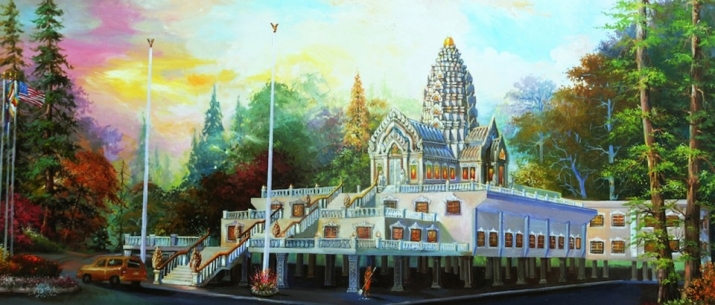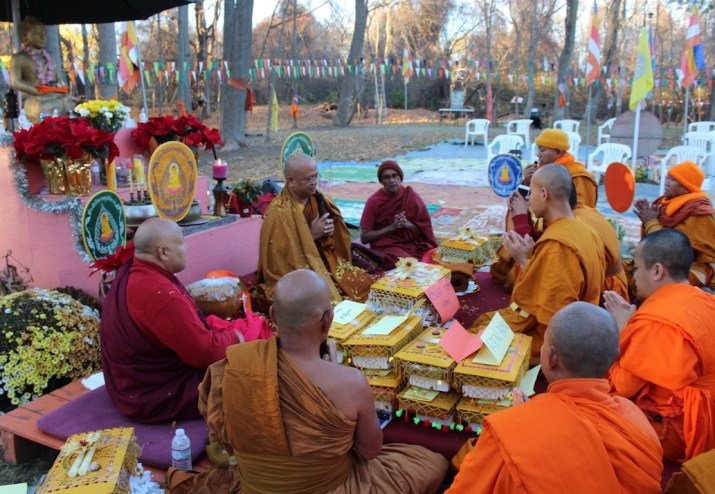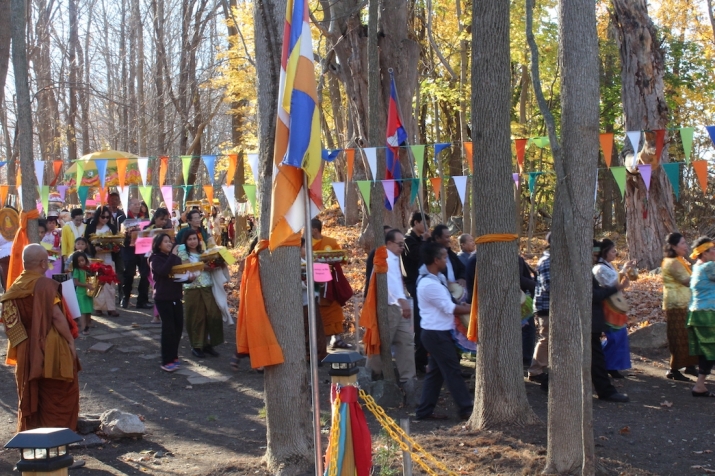FEATURES|COLUMNS|Buddhism in America (inactive)
When the Dharma Came to Lowell
 An artist's impression of the planned Buddhist temple. From vattkhmerlowell.org
An artist's impression of the planned Buddhist temple. From vattkhmerlowell.orgOnce known as the cradle of the American Industrial Revolution, the city of Lowell, Massachusetts, is now the site of a completely different form of transformation. The home of one of America’s largest Cambodian communities, Lowell is also the site of an ambitious initiative to preserve Cambodian Buddhism and culture for future generations of Cambodian Americans in the form of a spectacular Theravada Buddhist temple and cultural center.
Located some 25 miles northwest of Boston, Lowell sits on the banks of the Merrimack River. The founding of the city in 1820 transformed a quiet Massachusetts farming community into an industrial center for cotton grown in the American South, and by the 1850s it had become the largest industrial center in the United States. At its economic height, Lowell’s many factories employed countless immigrants—Irish people who fled the 1830–40 potato famine, as well as German, Swedish, Jewish, Greek, Lithuanian, and French-Canadian immigrants, among others—all flocking to the city to seek their fortunes.
During the 1970s, the city received thousands of ethnic Khmer refugees fleeing the repressive Khmer Rouge regime that laid waste to Cambodia and attempted to stamp out Theravada Buddhism in the country. As a result of that influx, this former mill town is now home to a thriving population of some 30,000 Cambodian-Americans—the second-largest population of Cambodians in the United States after Long Beach in southern California.
Over the intervening years, as Lowell’s Cambodian community prospered, its members were able to strengthen their cultural and religious ties to their ancestral homeland, and many small Theravada Buddhist temples sprung up around the city. In 2011, 12 acres of land were purchased and a new, larger temple was built to serve the community, along with a monastic residence and a public shrine that is the focal point for the cultural and religious events that are held at the site.
 Venerable Dr. Bhikkhu Praghyalok with other monastics at Vatt Khmer Lowell. Photo by Venerable Dr. Bhikkhu Praghyalok
Venerable Dr. Bhikkhu Praghyalok with other monastics at Vatt Khmer Lowell. Photo by Venerable Dr. Bhikkhu PraghyalokPlans are now in place to develop an even larger monastery at the site, along with a Khmer-American cultural center. Targeted for completion by 2020, the temple—to be named Vatt Khmer Lowell—will be a blend of traditional Khmer architecture and modern building design. The visually stunning main structure will feature a prominent redented tower reminiscent of Cambodia’s famed Angkor Wat, the world’s largest religious monument. Initially designed and constructed as a Hindu temple in the first half of the 12th century, during the reign of Suryavarman II (r. c. 1113–50), Angkor Wat became a Buddhist temple towards the end of the century. The complex is one of the most important archaeological sites in Southeast Asia and arguably the most recognizable symbol of the Kingdom of Cambodia, even appearing on the national flag.
Venerable Sao Khon Dharma Thero, the president of Community of Khmer Buddhist Monks Inc. (CKBM), which is behind the initiative, says the project is aimed at preserving the cultural and spiritual practices of the local community, while incorporating elements of American culture. CKBM was incorporated in 1993 with the mission of encouraging unity among Khmer Buddhist monks and lay practitioners in Lowell and promoting Theravada Buddhism and Cambodian cultural traditions.
With the participation of Buddhists and non-Buddhists, Cambodians and non-Cambodians, donations for the project have been received from all over the world. An ongoing campaign to raise US$10 million for the project dubbed “The 84,000 Buddha Campaign” has been launched, under which 84,000 Buddha statues will be permanently enshrined within the temple complex, each with the name of the donor engraved in the base. Given the ecumenical flavor of the campaign, one might say that Lowell is becoming a universal center for the practice of Dharma.
The 84,000 Buddha Campaign was inspired by the collection of Buddhist teachings known as the Tripitaka, in which the number 84,000 is derived from the total number of teachings: 21,000 sutras (canonical scriptures), 21,000 Vinaya rules (the code of monastic discipline), and 42,000 Abhidhamma texts (higher teachings). The significance of the number was even recognized during the time of the emperor Ashoka (r. c. 268–232 BCE), whose empire encompassed much of the Indian subcontinent. Filled with remorse after his bloody conquest of Kalinga resulted in the deaths of tens of thousands of soldiers and civilians, Ashoka converted to Buddhism and went on to order the construction of 84,000 stupas across South and Central Asia.
Built upon land that has been blessed by several years of traditional Theravada ceremonies observed by the monks and the lay Buddhist community, the new 30,000-square-foot temple and cultural space will offer American children of Cambodian heritage the opportunity to learn the Khmer language and the culture of their ancestors. There are also plans for a library and a museum of Khmer culture that will serve as an educational and research site, linking with the nearby campus of the University of Massachusetts at Lowell.
 Kathina (robe-offering) ceremony at the end of the monastic rains retreat at Vatt Khmer Lowell. Photo by Samnang Khouen
Kathina (robe-offering) ceremony at the end of the monastic rains retreat at Vatt Khmer Lowell. Photo by Samnang KhouenFuture plans, which include acquiring properties in the vicinity of the temple site to be used as residences for female monastics and the elderly, are also in development. Five hundred monks will attend the planned inauguration of Vatt Khmer in 2020, recalling the 500 monks present at the first Buddhist council that was held the year following the parinirvana of the historical Buddha, Shakyamuni, some 2,500 years ago.
The advent of this major Theravada Buddhist complex symbolizes the way in which the cultural landscape of this former mill town is reincarnating once again, reflecting the fluid, ever-changing American demographic. From its beginnings, the city of Lowell has served as a refuge for people fleeing suffering, and now the Buddha, the refuge of the Dharma, and the monastic sangha have come to bless this city of immigrants, refugees, and their growing families.
See more
Vatt Khmer, Lowell, Massachusetts (Homepage)














